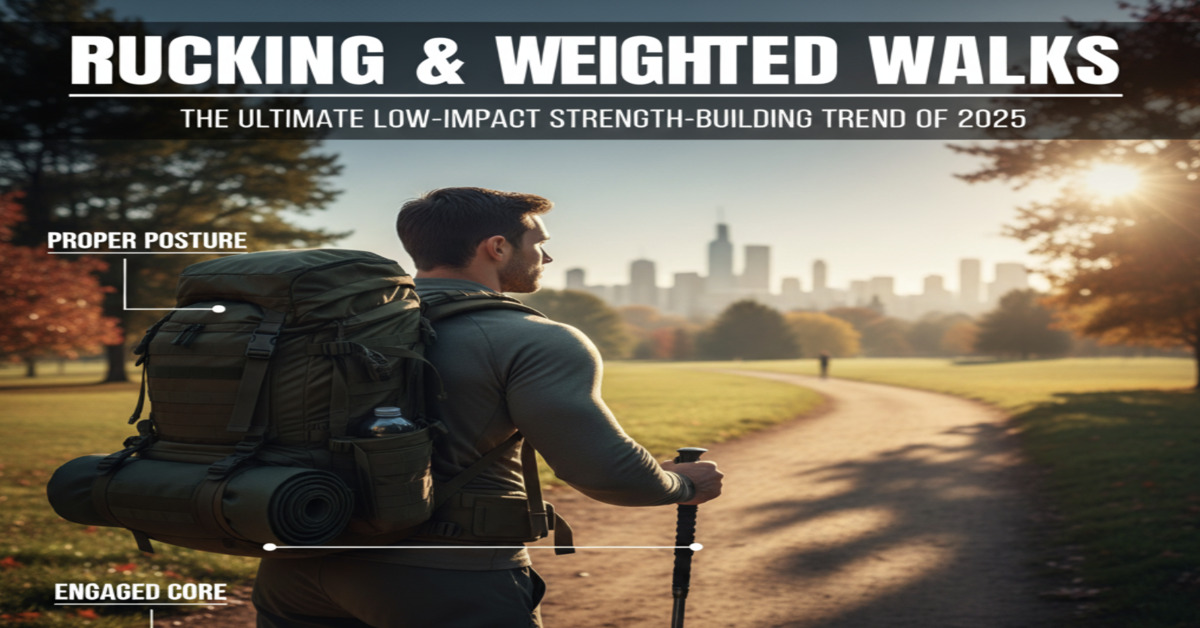Introduction: What Is Rucking?
Rucking is the simple yet powerful practice of walking or hiking while carrying added weight, typically in a backpack or weighted vest. Originating from military training, rucking has evolved into a low-impact, highly effective fitness trend for Americans in 2025 seeking fat loss, strength, and joint-friendly workouts.
Unlike running or high-intensity workouts, rucking allows you to burn calories, build endurance, and strengthen muscles without excessive joint stress. It’s accessible to all fitness levels and can be done anywhere — parks, city streets, or trails.

The Science Behind Weighted Walks
Rucking combines aerobic exercise with resistance training. Carrying extra weight increases your heart rate and energy expenditure, enhancing cardiovascular fitness while engaging multiple muscle groups, including:
- Quadriceps, hamstrings, and glutes
- Core stabilizers
- Upper back and shoulder muscles
Calories burned: Studies indicate that adding 10–20% of your body weight while walking can increase calorie burn by 20–50%, depending on pace and terrain.
Metabolic benefits: Weighted walks improve insulin sensitivity, lipid metabolism, and mitochondrial efficiency — supporting both fat loss and long-term metabolic health.
Why Rucking Matters in 2025
Modern Americans face high sedentary lifestyles, rising obesity, and joint-related injuries. Traditional high-impact workouts often discourage beginners or older adults.
Rucking fills this gap by offering:
- Low-impact, sustainable fitness
- Full-body engagement
- Mental health benefits: walking outdoors boosts mood and reduces stress
A 2024 study in the Journal of Applied Physiology found participants doing weighted walks 3x per week improved cardiovascular markers and functional strength significantly in just 8 weeks.
Core Benefits of Rucking & Weighted Walks
1. Cardiovascular & Fat-Burning Benefits
- Moderate-intensity weighted walking elevates heart rate without excessive strain
- Burns 400–600 calories per hour depending on weight load and pace
- Improves blood pressure, cholesterol, and VO2 max
2. Strength & Muscle Endurance
- Engages legs, glutes, core, and shoulders
- Builds muscular endurance for daily activities
- Improves posture and balance, reducing fall risk
3. Joint Health & Longevity
- Low-impact, safe for knees and hips
- Strengthens muscles supporting joints, reducing osteoarthritis risk
- Supports functional longevity for older adults
4. Mental Resilience & Stress Relief
- Walking outdoors releases endorphins and reduces cortisol
- Weighted challenges enhance mental toughness and focus
- Promotes mindfulness and mental clarity
How to Start: Step-by-Step Guide
- Choose the Right Load: Beginners start with 5–10% of body weight, progressing gradually.
- Select Comfortable Gear: Well-padded backpack or adjustable weighted vest.
- Start with Short Walks: 15–20 minutes on flat terrain, 2–3 times per week.
- Progress Slowly: Increase time, weight, or incline gradually to avoid injury.
- Incorporate Intervals: Alternate brisk walking with moderate pace for fat loss.
- Maintain Proper Form: Keep core engaged, shoulders relaxed, and avoid leaning forward.
Gear Essentials & Safety Tips
| Gear | Purpose | Recommendation |
|---|---|---|
| Weighted Backpack | Primary weight carrier | Adjustable straps, padded back |
| Weighted Vest | Optional alternative | 10–40 lbs, evenly distributed |
| Supportive Shoes | Reduce joint strain | Cushioned walking shoes or trail sneakers |
| Hydration Pack | Maintain performance | Water bladder or bottles |
| Reflective Gear | Outdoor safety | Vests, bands, lights |
Tip: Start with lighter weights and gradually progress; listen to your body to avoid back or joint strain.
Actionable Rucking Checklist
☑ Begin with 5–10% body weight
☑ Warm-up 5–10 minutes before walking
☑ Maintain upright posture
☑ Hydrate before, during, and after walks
☑ Cool down and stretch post-ruck
☑ Track distance, pace, and weight for progressive overload
☑ Ruck 2–4 times per week consistently
Sample Weekly Rucking Routine Table
| Day | Duration | Weight Load | Notes |
|---|---|---|---|
| Monday | 20 min | 10% BW | Flat terrain, moderate pace |
| Wednesday | 30 min | 12% BW | Slight incline, brisk pace |
| Friday | 25 min | 15% BW | Intervals: 3 min brisk / 2 min moderate |
| Sunday | 40 min | 10% BW | Leisurely recovery walk, enjoy outdoors |
Expert Insights on Rucking
“Rucking is a low-impact, full-body workout that anyone can scale,”
says Dr. Michael Stern, MD, Exercise Physiologist.
“It bridges cardiovascular health, strength, and functional mobility, making it ideal for long-term wellness.”
“Weighted walks improve endurance and metabolic health without the joint stress of running,”
adds Emily Torres, Functional Fitness Specialist.
Common Myths & FAQs
Q1: Will rucking make me bulky?
A: No, it primarily builds endurance, tone, and functional strength rather than extreme muscle mass.
Q2: Is rucking only for military or hikers?
A: Absolutely not. Beginners, busy professionals, and older adults can safely ruck.
Q3: How heavy should my backpack be?
A: Start with 5–10% of your body weight and progress slowly to 15–20% over weeks.
Q4: Can rucking replace cardio or weight training?
A: It can complement both — offering cardiovascular, muscular, and fat-loss benefits simultaneously.
Authoritative Resources
- American Council on Exercise – Rucking Benefits
- Harvard Health Publishing – Walking for Fitness
- National Institute on Aging – Strength and Mobility
- Journal of Applied Physiology – Weighted Walking Studies
Conclusion & Call-to-Action
Rucking & Weighted Walks are an underrated yet highly effective fitness trend in 2025. They provide:
- Fat-burning and metabolic benefits
- Strength and muscle endurance
- Joint-friendly, low-impact training
- Mental resilience and stress reduction
Next Step: Start small with 5–10% body weight, follow a structured routine, and progressively increase intensity. Track your progress, pair with proper nutrition, and enjoy the long-term health benefits of this functional, low-impact training.
Related Articles You May Like:


1 thought on “Rucking & Weighted Walks: The Ultimate Low-Impact Strength-Building Trend of 2025”